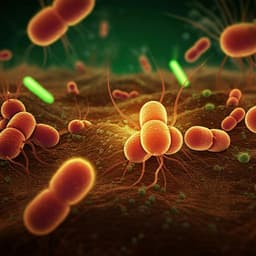
Environmental Studies and Forestry
Methanogenesis in the presence of oxygenic photosynthetic bacteria may contribute to global methane cycle
J. Ye, M. Zhuang, et al.
This groundbreaking study reveals a novel mechanism for methane production in surface waters, highlighting the interaction between oxygenic photosynthetic bacteria and anaerobic methanogenic archaea. Conducted by Jie Ye and colleagues, the research implies that this light-driven methanogenesis could significantly influence the global methane cycle.
~3 min • Beginner • English
Introduction
Atmospheric methane (CH4) reached exceptionally high concentrations in 2022, motivating efforts to understand and address emissions from freshwater ecosystems, which are major contributors to the global methane budget. Traditionally, CH4 in freshwater has been attributed to anaerobic transformation of organic matter in sediments. However, widespread CH4 supersaturation in oxic surface waters (the methane paradox) indicates a significant, yet undefined, CH4 production process in surface layers. Oxygenic photosynthetic bacteria dominate these surface layers and possess versatile metabolisms and motility. While correlations between photosynthetic bacteria and CH4 production under illumination have been reported, mechanisms remain unresolved. The prevailing view that methanogenic archaea are highly oxygen-sensitive has obscured potential roles for oxygenic phototrophs, despite evidence of co-occurrence and close attachment between methanogens and photosynthetic microbes in oxygenated, methane-rich habitats (e.g., microbial mats, soil crusts, oligotrophic lake epilimnia). Methanogens can survive oxygen exposures, suggesting possible interactions via nutrient exchange or signaling. Clarifying photosynthetically regulated CH4 production is thus ecologically and biogeochemically important for understanding the global CH4 cycle.
Literature Review
Prior work has linked phototrophic microorganisms to methane production, including photosynthesis-driven CO2 reduction via nitrogenase in anoxygenic bacteria and reports of aerobic CH4 production by phytoplankton. The role of oxygenic photosynthetic bacteria remains poorly defined. Observations of methanogens coexisting with phototrophs in oxygenated environments, along with evidence that methanogens can tolerate brief oxygen exposure, suggest potential interactions enabling CH4 generation in oxic waters. The methane paradox (CH4 supersaturation in surface waters above atmospheric equilibrium) further implies additional production pathways. Earlier studies proposed light-driven methanogenesis in anoxygenic phototroph–methanogen cocultures under strictly anoxic conditions; the contribution of oxygenic phototrophs and iron redox chemistry had not been elucidated.
Methodology
Coculture setup: Synechocystis sp. PCC 6803 (PCC6803) and Methanosarcina barkeri (DSM 800) were cocultured in a defined autotrophic medium (CO2 as the sole carbon source) with varying concentrations of Fe-EDTA to provide soluble iron and enable Fe(II)/Fe(III) redox cycling. Cultures were initially sparged with sterile N2/CO2 (80/20, v/v) to establish anaerobic conditions and preincubated in the dark for 24 h. Light-driven experiments ran at 35 °C under visible LEDs (12 ± 0.6 W m−2, 380–800 nm) in periodic light–dark cycles (primarily 4 h light/20 h dark; some tests at 12 h/12 h). CH4 production was tracked over three successive 18-day cycles; single-factor controls removed PCC6803, M. barkeri, Fe-EDTA, or light. An outdoor validation was conducted under natural sunlight and ambient temperatures in Fuzhou, China.
Isotopic tracing: 13C-labeled NaHCO3 served as the sole carbon source to confirm CO2-to-CH4 conversion by GC–MS (monitoring m/z 45 for CO2 and m/z 17 for CH4). 18O2 labeling identified ROS origin via LC–MS detection of DMPO-18OH adducts.
Hydrogen pathway perturbation: Sodium 2-bromoethanesulfonate (SBES) inhibited methanogenic hydrogenases to assess the hydrogenotrophic contribution (CO2 + 4H2 → CH4 + 2H2O).
Biofilm visualization: Cocultures formed biofilms at the bottle bottom. Biofilms and cell associations were characterized by optical microscopy, FISH (PCC6803 autofluorescence; M. barkeri with FAM-labeled probe), and CLSM to measure thickness over time.
Electrochemical analyses: Photocurrent generation by PCC6803 and possible interspecies electron transfer were examined in single-chamber microbial fuel cells (−0.5 V bias) and two-chamber H-cells (separating species to limit direct electron exchange), under light and dark conditions.
Transcriptomics: Strand-specific RNA-seq profiled gene expression oscillations across light–dark phases, mapping clean reads to PCC6803 and M. barkeri reference genomes. Analyses focused on photosystems, Calvin cycle, TCA cycle, fermentation pathways, hydrogenases, methanogenesis genes, and iron uptake/transport systems.
Chemical analyses: CH4 and H2 were quantified by GC (FID/TCD). Dissolved oxygen was measured by micro-oxygen sensor, revealing periodic oxic–anoxic transitions. Organic intermediates (lactate, pyruvate, acetate, methanol) were identified by 1H NMR, gCOSY, and gHMBC; acetate quantified by GC-FID. ROS species were detected by EPR spin trapping (DMPO for •OH and •O2−, TEMPO for O2) and quantified via UV–Vis methods (o-tolidine for H2O2; terephthalic acid for •OH). Iron speciation (Fe(II), Fe(III), Fe_total) was measured by ferrozine assay and hydroxylamine reduction. DMS and DMSP as methyl donors were identified/quantified by GC–MS, including alkaline cleavage of DMSP to DMS. Chlorophyll a and PSII quantum yield (Fv/Fm) were determined spectroscopically.
Universality tests: Additional oxygenic phototrophs (Tribonema minus, Euglena gracilis, Chlorella sp.) were cocultured with different methanogens (Methanobacterium bryantii, Methanococcoides orientis, Methanosphaera stadtmaniae). Different Fe species (e.g., zero-valent iron, Fe3O4/FeCl2; ferric citrate/oxalate) were tested for their effects on methanogenesis.
Key Findings
- Light-driven CH4 production emerged only when all components were present (PCC6803, M. barkeri, Fe-EDTA, and light). Removing any component markedly decreased yields.
- CH4 yields: coculture without Fe-EDTA produced 1.0 ± 0.1 μmol; with Fe-EDTA produced 2.5 ± 0.5 μmol, showing a linear correlation with Fe-EDTA concentration. CH4 accumulated during both light and dark phases, increasing over successive cycles as a stable syntrophic biofilm formed.
- Isotopic evidence: With 13C-NaHCO3 as sole carbon source, labeled CO2 (m/z 45) and 13CH4 (m/z 17) were detected, confirming CO2-to-CH4 conversion. Residual unlabeled signals (m/z 44 and 16) suggest utilization of biomass-derived or oxidation intermediates.
- Biofilm and microenvironment: PCC6803 and M. barkeri formed dense coculture biofilms; thickness increased from ~30 μm to ~45 μm over 10 days. Dissolved oxygen oscillated with light–dark cycles; Fe-EDTA lowered DO during light and accelerated oxygen consumption in dark, facilitating an anoxic microenvironment and increasing mcrA and cpcG gene copy numbers.
- Substrate/intermediate profiles: NMR identified lactate, pyruvate, acetate, and methanol as intermediates. Acetate accumulation was lower in cocultures than in PCC6803-alone, consistent with aceticlastic consumption by M. barkeri.
- H2 involvement: H2 was detected in headspace; its yield was lower in cocultures than in PCC6803-alone, implying H2 consumption by methanogenesis. Inhibiting methanogenic hydrogenases with SBES increased residual H2 and decreased CH4, supporting a hydrogenotrophic pathway contribution.
- Electron transfer: Photocurrents were observed under illumination; weaker currents in darkness indicate extracellular electron release by PCC6803, with potential DIET in dark. Under illumination, oxygen sensitivity of M. barkeri likely limits DIET.
- Transcriptomics: Light-period upregulation of PSII, cytochrome b6f, PSI, FNR, ATP synthase, and Calvin cycle genes (rbc, prk, gap) indicated active photosynthesis and CO2 fixation. TCA cycle and genes for lactate/acetate biosynthesis increased. Iron uptake/transport genes (Fut/Feo) were upregulated, supporting Fe redox cycling. In darkness, genes for pyruvate oxidation (Por), acetate metabolism (Ack, Pta, Codh/Acs), methanogenesis (Fmd, Ftr, Mch, Mtd, Mer, Mtr, Mcr) and hydrogenases (Ech, Vht, Fpo) were upregulated, indicating multiple CH4 pathways.
- ROS-driven abiotic pathway: EPR detected •OH, •O2−/O2, and •CH3 radicals; UV–Vis confirmed H2O2 production. ROS concentrations (especially •OH, H2O2) increased under illumination. Fe(II) oxidation via Fenton chemistry increased Fe(III) in light; Fe(III) was reducible by PCC6803, establishing Fe(III)/Fe(II) cycling. DMS and DMSP were identified as methyl donors; ROS oxidized methyl donors to •CH3, yielding abiotic CH4. Quenching •OH with tert-butyl alcohol reduced CH4 yield from 2.5 μmol to 0.5 μmol, implying ~65.4% abiotic contribution and ~34.6% biotic (syntrophic) contribution to total CH4.
- Detoxification: Antioxidant defenses (superoxide dismutase, catalases, peroxidases) were upregulated, mitigating ROS stress.
- Generality: Other oxygenic phototrophs (Tribonema minus, Euglena gracilis, Chlorella sp.) produced CH4 with methanogens. Different methanogens (hydrogenotrophic, methylotrophic, aceticlastic) also supported CH4 production. Various Fe species enhanced performance. Outdoor tests under natural sunlight reproduced light-driven methanogenesis. Approximately 5.9% of gross primary production was diverted to CH4 formation in the coculture system.
Discussion
The study reveals a previously underappreciated coupling between oxygenic photosynthesis and methanogenesis that helps explain methane supersaturation in oxic surface waters. During illumination, oxygen evolved by PCC6803 promotes ROS formation (including via M. barkeri under O2 exposure), which oxidizes methyl donors to methyl radicals and drives abiotic CH4 formation while also catalyzing Fe(II) oxidation. During darkness, respiratory activity and hydrogen/formate production by PCC6803, combined with reduced oxygen levels and Fe redox cycling, support syntrophic biotic methanogenesis by M. barkeri via aceticlastic and hydrogenotrophic pathways. The periodic light–dark cycles establish alternating oxic–anoxic microenvironments, enabling both abiotic and biotic CH4 production modes. Transcriptomic data corroborate phase-specific metabolic activities and iron uptake, while chemical analyses verify ROS and methyl-donor chemistry. The universality across diverse phototrophs, methanogens, and iron species suggests this mechanism may be widespread and contribute significantly to the global CH4 cycle beyond conventional acetoclastic and hydrogenotrophic routes. Nevertheless, quantifying in situ relevance and partitioning contributions under natural conditions remains necessary.
Conclusion
This work demonstrates that oxygenic photosynthetic bacteria can drive CH4 production through two synergistic mechanisms: (1) syntrophic methanogenesis in dark, anoxic phases fueled by PCC6803-derived organics and H2, and (2) abiotic methanogenesis in light, oxic phases via ROS oxidation of methyl donors, both enhanced by Fe(III)/Fe(II) redox cycling. The process occurs across multiple phototroph and methanogen taxa and with common iron species, indicating potential prevalence in nature and relevance to the methane paradox. Approximately 5.9% of gross primary production can be diverted to CH4 in the studied system. Future research should validate this mechanism in situ (e.g., CH4 profiles, community analyses), quantify abiotic versus biotic contributions under environmental conditions, and assess roles of other metals (e.g., manganese) in mediating light-driven methanogenesis.
Limitations
Findings are derived primarily from controlled laboratory cocultures; the extent and variability of this mechanism in natural ecosystems remain unverified. The precise partitioning of abiotic and biotic CH4 formation in situ is uncertain and may vary with light regime, oxygen dynamics, community composition, and iron speciation. Oxygen sensitivity of methanogens may limit light-phase biotic processes. DO accumulation slowed CH4 production after day 2, indicating dynamic feedbacks. Additional metals beyond iron may participate, requiring further evaluation. Comprehensive in situ measurements and incubation experiments with environmental consortia are needed to establish prevalence and quantify contributions to methane budgets.
Related Publications
Explore these studies to deepen your understanding of the subject.







